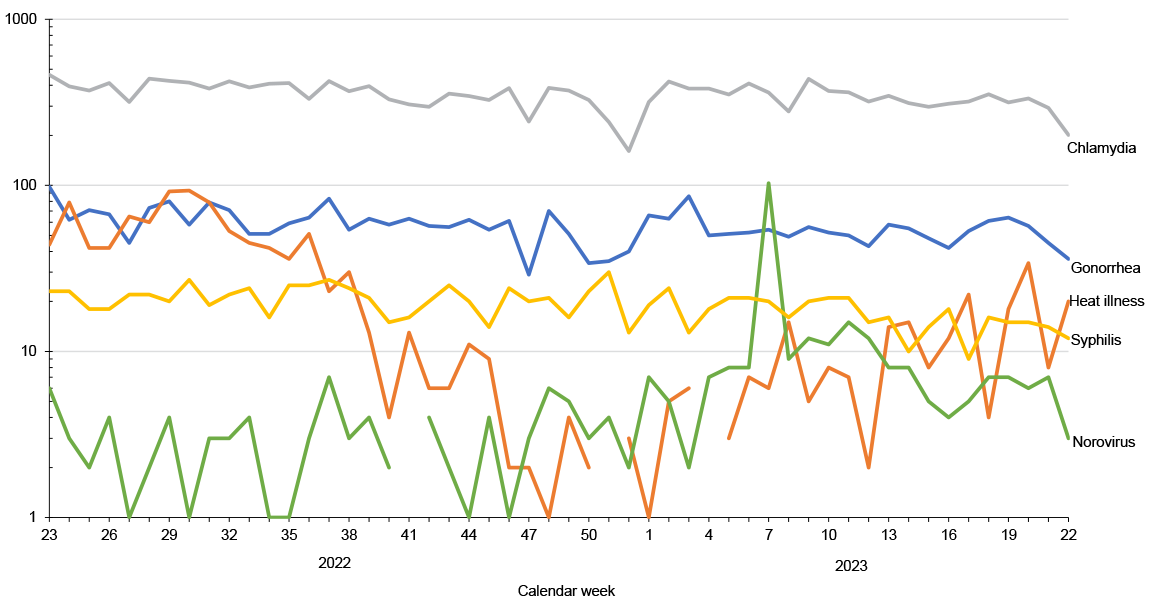Reportable Medical Events, Military Health System Facilities, Week 22, Ending June 3, 2023
 Graph depicting the frequency of the five most common reportable medical events within the Military Health System over the preceding year.
Graph depicting the frequency of the five most common reportable medical events within the Military Health System over the preceding year.
Reportable Medical Events are documented in the Disease Reporting System internet by health care providers and public health officials across the Military Health System for the purpose of monitoring, controlling, and preventing the occurrence and spread of diseases of public health interest or readiness importance. These reports are reviewed by each service’s public health surveillance hub. The DRSi collects reports on over 70 different RMEs, including infectious and non-infectious conditions, outbreak reports, STI risk surveys, and tuberculosis contact investigation reports. A complete list of RMEs is available in the 2022 Armed Forces Reportable Medical Events Guidelines and Case Definitions.1 Data reported in these tables are considered provisional and do not represent conclusive evidence until case reports are fully validated.

Total active component cases reported per week are displayed for the top five RMEs for the previous year. Each month, the graph is updated with the top five RMEs, and is presented with the current month’s (May 2023) top five RMEs, which may differ from previous months. COVID-19 is excluded from these graphs due to changes in reporting/case definition updates in 2023.

References
- Armed Forces Health Surveillance Division. Armed Forces Reportable Medical Events. Accessed April 6, 2023. https://www.health.mil/Military-Health-Topics/Health-Readiness/AFHSD/Reports-and-Publications/Armed-Forces-Reportable-Medical-Events
- Defense Manpower Data Center. Department of Defense Active Duty Military Personnel by Rank/Grade of Service, October 31, 2022. https://dwp.dmdc.osd.mil/dwp/app/dod-data-reports/workforce-reports
- Defense Manpower Data Center. Armed Forces Strength Figures for January 31, 2023. https://dwp.dmdc.osd.mil/dwp/app/dod-data-reports/workforce-reports
- Navy Medicine. Surveillance and Reporting Tools–DRSI: Disease Reporting System Internet. https://www.med.navy.mil/Navy-Marine-Corps-Public-Health-Center/Preventive-Medicine/Program-and-Policy-Support/Disease-Surveillance/DRSI
You also may be interested in...
Report
Jan 1, 2016
 .PDF |
1.42 MB
.PDF |
1.42 MB
A monthly publication of the Armed Forces Health Surveillance Branch. This issue of the peer-reviewed journal contains the following articles: Editorial: What's old is new again: syphilis in the U.S. Army; Use of quadrivalent human papillomavirus vaccine and the prevalence of antibodies to vaccine-targeted strains among female service members before ...
Report
Jan 1, 2016
 .PDF |
1.51 MB
.PDF |
1.51 MB
A monthly publication of the Armed Forces Health Surveillance Branch. This issue of the peer-reviewed journal contains the following articles: Obstructive sleep apnea and associated attrition, active component, U.S. Armed Forces, January 2004–May 2016; Update: Cold weather injuries, active and reserve components, U.S. Armed Forces, July 2011–June ...
Video
Dec 28, 2015
Corpsmen and Marines rehearsed life-saving skills during Exercise Steel Knight’s mass casualty drill, Dec. 12, 2015. Steel Knight provides tough, realistic training for the Marines and sailors of 1st Marine Division.
Report
Dec 15, 2015
 .PDF |
23.24 MB
.PDF |
23.24 MB
In this annual report, you will see that the Armed Forces Health Surveillance Center continued to make significant strides in supporting public health surveillance for the Department of Defense to maintain the health and readiness of its forces, and contribute to the global health security of its allies.
Presentation
Nov 9, 2015
 .PDF |
213.21 KB
.PDF |
213.21 KB
Decision Brief: Neurological/Behavioral Health Subcommittee Automated Neuropsychological Assessment Metrics 4 Tasking
Presentation
Nov 9, 2015
 .PDF |
735.97 KB
.PDF |
735.97 KB
6th Medical Group Overview and Mental Health/Suicides/Post Traumatic Stress Disorder and Veterans Affairs Collaboration
Policy
Sep 11, 2015
This instruction establishes policy, assigns responsibilities, and prescribes standard elements, pursuant to section 722 of Public Law 111-383, requiring the implementation of a comprehensive neurocognitive assessment policy in the military services.
- Identification #: DODI 6490.13
- Type: Instruction
Presentation
Aug 20, 2015
 .PDF |
16.94 MB
.PDF |
16.94 MB
Health Diplomacy: U.S. Navy Medical Response to the Tsunami in Indonesia
Presentation
Aug 20, 2015
 .PDF |
1.39 MB
.PDF |
1.39 MB
Biomedical Innovations for Infectious Diseases and Military Psychiatry and Neuroscience
Presentation
Aug 20, 2015
 .PDF |
132.54 KB
.PDF |
132.54 KB
Neurological/Behavioral Health Subcommittee Update
Presentation
Aug 20, 2015
 .PDF |
2.38 MB
.PDF |
2.38 MB
U.S. Army Medical Research Institute of Infectious Disease Biosafety/Biosecurity/Biosurety and Ebola Response Support
Presentation
May 12, 2015
 .PDF |
156.53 KB
.PDF |
156.53 KB
Scientific Evidence of Using Population Normative Values for Post-Concussive Computerized Neurocognitive Assessments
FAQ
Jul 31, 2024
Questions and answers about Project 112 SHAD
Report
May 8, 2015
 .PDF |
29.62 KB
.PDF |
29.62 KB
Edgewood Arsenal has been the center of chemical warfare research and development since 1918. Therefore, it is not surprising that Edgewood Arsenal became the research hub for chemical agent testing on human subjects from 1955 through 1975. The great majority of the use of volunteers in medical (chemical) research occurred at this installation.
Report
May 8, 2015
 .PDF |
195.65 KB
.PDF |
195.65 KB
The U.S. Army established its offensive Biological Warfare program at Fort Detrick in 1943. The purpose of the program was twofold: develop defensive mechanisms against biological attack and develop weapons with which the United States could respond “in kind” if attacked by an enemy who used biological weapons.
You are leaving Health.mil
The appearance of hyperlinks does not constitute endorsement by the Department of Defense of non-U.S. Government sites or the information, products, or services contained therein. Although the Defense Health Agency may or may not use these sites as additional distribution channels for Department of Defense information, it does not exercise editorial control over all of the information that you may find at these locations. Such links are provided consistent with the stated purpose of this website.
You are leaving Health.mil
View the external links disclaimer.
Last Updated: August 24, 2023